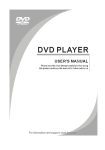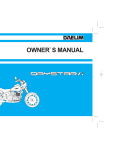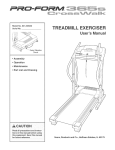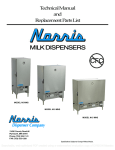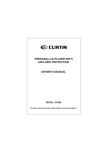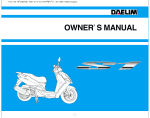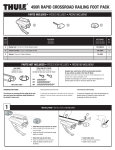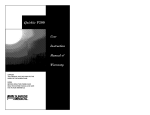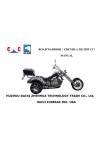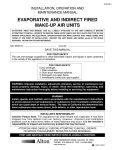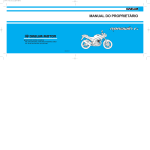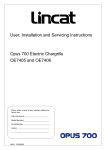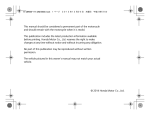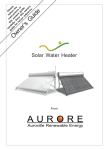Download OWNER S MANUAL
Transcript
OWNER S MANUAL HEAD OFFICE(FACTORY) #58, SUNG SAN-DONG, CHANG WON, KYUNGNAM, KOREA TEL: (82-55) 239-7000 / FAX: (82-2) 467-9997 IMPORTANT NOTICE ● WELCOME Thank you for purchasing an Daelim vehicle. We hope you enjoy safe riding. ● OPERATOR AND PASSENGER This motorcycle is designed to carry the operator and one passenger. WARNING Attempting to change the pre-set maximum speed may cause danger and will void the Daelim warranty. ● ● ON-ROAD USE This motorcycle is designed to be used only on the road. READ THIS OWNER'S MANUAL CAREFULLY Pay special attention to statements preceded by the following words: WARNING Indicates a strong possibility of severe personal injury or death if instructions are not followed. CAUTION Indicates a possibility of personal injury or equipment damage if instructions are not followed. NOTE Gives helpful information. This manual is an important and integral part of your vehicle. keep it with your vehicle at all times, even though your vehicle is resold. 2007. 04 PRINTED 2007. 04 PUBLICATION NO COPY CONTENTS HORN BUTTON ................................................................. 16 SPECIFICATION ...................................................................... 3 OPERATION INSTRUCTION .............................................. 4 EQUIPMENT USAGE ........................................................ 17 PRECAUTIONS .................................................. 4 STEERING LOCK .............................................................. 17 PRIOR TO STARTING VEHICLE ........................................ 5 SEAT .................................................................................. 17 CORRECT ATTIRE ............................................................. 5 HELMET HOLDER ............................................................ 18 OPERATION ........................................................................ 6 STORAGE COMPARTMENT ............................................ 18 CARGO ................................................................................ 7 SELF INSPECTIONS BEFORE OPERATION .......... 19 MODIFICATION ................................................................... 8 BRAKES ............................................................................ 19 ATTACHMENT .................................................................... 8 TIRES ................................................................................ 21 MUFFLER ............................................................................ 8 CLUTCH ............................................................................ 23 LOCATION.............................................................. 9 FUEL .................................................................................. 24 METER READING AND USAGE................................... 12 ENGINE OIL ...................................................................... 25 METER .............................................................................. 13 LIGHTS AND WINKER ...................................................... 25 TACHOMETER .................................................................. 13 BACK MIRROR .................................................................. 26 FUEL GAUGE .................................................................... 13 LICENSE PLATE ............................................................... 26 INDICATOR LAMPS .......................................................... 13 OPERATION ........................................................................ 26 MALFUNCTION INDICATOR LAMPS ............................... 13 PRE-RIDE INSPECTION ................................................... 26 SWITCH OPERATION ...................................................... 14 STARTING THE ENGINE .................................................. 27 MAIN SWITCH ....................................................................14 IF ENGINE CANNOT BE STARTED ................................. 28 KEYS ................................................................................. 15 RUNNING-IN ..................................................................... 28 HEADLIGHT ...................................................................... 15 RIDING .............................................................................. 29 STARTER BUTTON .......................................................... 16 BRAKING ........................................................................... 30 WINKER SWITCH ............................................................. 16 PARKING ........................................................................... 30 SAFETY PARTS 1 2 MAINTENANCE .................................................................. 31 SAFE DRIVING....................................................................... 51 MAINTENANCE SCHEDULE ............................................ 32 PREPARATION BEFORE DRIVING ............................ 51 TOOL KIT ........................................................................... 34 DRIVING METHOD ............................................................ 52 FRAME AND ENGINE NUMBERS .................................... 34 DRIVING POSITION ...........................................................52 MAINTENANCE PRECAUTIONS ...................................... 35 PRECAUTION WHEN DRIVING ....................................... 53 THROTTLE OPERATION .................................................. 35 STARTING ......................................................................... 54 AIR CLEANER ................................................................... 36 TURNING METHOD .......................................................... 55 ENGINE OIL ...................................................................... 37 PRINCIPLE OF TURN ....................................................... 55 SPARK PLUG .................................................................... 38 EFFECT OF SPEED .......................................................... 55 DRIVE CHAIN .................................................................... 39 3 POSITIONS OF TURNING ............................................. 56 WHEEL REMOVAL ............................................................ 41 TURNING METHOD .......................................................... 57 BRAKE PAD WEAR ........................................................... 43 PRECAUTION WHEN TURNING ...................................... 58 SIDE STAND ..................................................................... 44 BRAKING METHOD .......................................................... 59 BATTERY .......................................................................... 45 BASIC PRINCIPLE OF BRAKE(FRICTION FORCE) ........ 59 FUSE REPLACEMENT ..................................................... 46 RESTRAINT OF BRAKE EFFECT (INERTIA) .................. 59 BULB REPLACEMENT ...................................................... 47 BRAKING METHOD .......................................................... 60 CABLE RUBBER PART ..................................................... 49 COMPARISION OF BRAKING DISTANCE ........................60 GENERAL CLEANING ...................................................... 49 IMPACT WHEN COLLISION ..............................................60 STORAGE GUIDE ............................................................. 50 WIRING DIAGRAM ............................................................... 62 SPECIFICATION 3 OPERATION INSTRUCTION SAFETY PRECAUTIONS This manual describes matters pertaining to correct operation, safe operation and simple maintenance of the vehicle you purchased. To ensure more comfortable and safer operation, make sure to read this manual carefully prior to operation. The photographs and drawings shown in this manual may differ from those of actual vehicles due to changes in vehicle specifications and modifications made. This vehicle is designed for 2 riders including the operator. Do not use polluted gasoline. Otherwse it cause rust inside the fuel tank, and close the suppiy of fuel to the injector, leading to an improper engine starting or may cause serious damage to engine. Do use genuine oil, then it will protect and extend vehicle life. Warranty does not apply to the motorcycles used in competitions or competitive trials. No motorcycle part may be tampered with, altered, or replaced with parts other than original Daelim spare parts during the warranty period. As far as any defect caused by contaminated gasoline or oil, the warranty will be automatically invalidated. 4 Careful driving and the wearing of proper attire and safety equipment are the most important factors in the safe operation of the daystar. Please obey traffic regulations and do not be hurried and careless. Many new vehicle owners operate their newly purchased vehicles with great care and attention to safety factors. However, after becoming accustomed to the operations are often discarded, which can lead to accidents. Please don't let this happen to you and always approach the operation of your vehicle with the safety considerations needed. When operating the vehicle, always keep in mind and obey the notes of precaution printed on the Safety Precaution Label attached to the vehicle. Be sure to wear helmet at all time. Be sure to put on gloves at all time. Observe the speed regulations. Beware of muffler affer driving as it is still hot to be burnt. Especially never children touch on it. For safety, do not change, alteration or modification the vehicle. Regularly conduct specified maintenance inspections. <Maintenance Inspection Points> Brakes, Tires, Oil, Lights, Horn, Instruments PRIOR TO STARTING VEHICLE CORRECT ATTIRE Read user's manual carefully. Conduct maintenance checks prior to operation. Always maintain vehicle in clean status and carry out specified maintenance checks. Make sure to stop engine and stay away from fire when fueling. Exhaust gas contains harmful substance such as carbon monoxide, Start engine in well-ventilated places. Be sure you and your passenger always wear a helmet, eye pretection and other protective apparel when you ride. Not wearing a helmet increases the chance of serious injury or death in a crash. 5 OPERATION Operators should naturally fix bodies to keep smooth driving. Please check whether or not you are unnaturally strained and strung up. Driving pose has a great influence on safe operation. Please always maintain the center of your body in the middle of seat. Especially do not sit at the rear seat because it may lessen the weight of front wheel and cause trembling steering wheel. When wanting to turn, slightly lean to body toward the direction of the turn. It is unsafe if the body is not moved in union with the motorcycle. Curvy roads and poor, unpaved roads constantly change in surface quality. Driving on these roads can be unsafe if certain safety precautions are not followed. In order to safely drive through these driving conditions, anticipate coming road conditions, slow down to at least half the normal speed, and relax your shoulders and wrists while securely holding the handles. Always hold the handle bars firmly with both hands whiling driving, otherwise, it cause severe injury or death of the driver. The pillion passenger should always hold on to the operator with both hands and keep both feet on the pillion step bar. otherwise, it cause severe injury or death. 6 Pay attention not to overload goods and fasten it tightly whiling driving. Do not place kind of cloth materials nearby oil tank cap. If the hole in oil tank cap is clogged, oil will not flow freely into the engine which can cause severely engine damage. Do not attach large or heavy items (such as a sleeping bag or tent) to the handle bars, fork, or fender. Unstable handling or sliw steering response may result. 7 MODIFICATION Modification of vehicle structure or function deteriorates manipulatability or causes exhaust noise to become louder shortening the vehicle life. These modifications are not only prohibited by law but also are the acts harmful to other people. Modifications are not covered by warranty. Improper accessories or modifications can cavse a crash in which you can be seriously hurt or killed. Follow all instruction in this owneris manual regarding accessories and modifications. MUFFLER As far as any defect caused by modifications, the warranty will be automatically invalidated. Pay particular attention to fellow passenger so that he/she can prevent getting burnt by the hot muffler during travel. ATTACHMENT Except designated attachment by DAELIM MOTOR CO.LTD., don’t attach any extra lighting device, because it may cause an early discharging of battery. Carefully inspect the accessory to make sure it does not obscure any lights, reduce ground clearance and banking angle, or limit suspension travel, steering travel or control operation. Do not add electrical equipment that will exceed the motorcycle’s electrical system capacity. A blown fuse could cause a dangerous loss of lights or engine power. This motorcycle was not designed to pull a sidecar or trailer. Handling may be seriously impaired if so equipped. 8 Beware of muffler after driving as it is still hot to be burnt. Especially never children touch on it. And pay attention to park where pedestrian zoon. If haystack or vinyl is stuck to the muffler, it might be fired. PARTS LOCATION 9 PARTS LOCATION 10 PARTS LOCATION REAR CUSHION HELMET HOLDER RADIATOR CALIPER PILLION STEP BAR BRAKE DISK GEAR SHIFT PEDAL MAIN STAND SIDE STAND MAIN STEP BAR 11 METER READING AND USAGE 12 MIL<MALFUNCTION INDICATION LAMP> Indicates amount of gasoline in fuel tank. If needle is within E mark,immediately fill gasoline. Balance at this time is approximately 4.0 litres. To avoid running out of fuel,it might cause serve injury due to engine abruptly stop. Running the engine beyond recommended maximum engine speed(the beginning of the tachometer red zone)can damage the engine. EMS(Engine Management System)is equipped with a self-diagnosis function in order to ensure that the engine control system is operation normally. If this function detects a malfunction in the system, the malfunction indicator lamp immediately operates. It gives the rider that malfunction has occurred in the system. Normally, the malfunction indicator lamp illuminates for 3 seconds when the main key is turned on. If the malfunction indicator lamp does not come on under these conditions, the malfunction indicator lamp may be defective. After 3 seconds, the malfunction indictor lamp off automatically. However, the MIL blinks continuously, check the EMS system. If you are not able to check the EMS system, contact your daelim dealers. The EMS takes fail-safe function, it enables to drive only temporary by starting even on conditioned. 13 SWITCH OPERATION Do not operate main switch key during operation. If the main switch key is placed on Off or Lock position, all electrical system will not function. Never operate the main switch key during travel as it might cause unexpected accidents. If it is necessary to remove the main switch key, stop the vehicle first prior to removing. Prior to dismounting from the vehicle, make sure to lock the steering wheel and remove key. If the key is left in “ON” position without starting engine, battery is discharged. Do not use a number of keys together with a metal key holder. The keys and the key holder may cause scratches or other damage to the cover while operating the vehicle.(Recommend cloth or leather key holders) 14 15 16 EQUIPMENT USAGE STEERING LOCK To lock the steering, turn the handlebars all the way to the left or right, turn the key to LOCK while pushing in. Remove the key. To unlock the steering, turn the key to OFF while pushing in. SEAT <FRONT SEAT> To remove the front seat, insert the ignition key into the seat lock. Turn the ignition key counterclockwise, and then pull the seat back and up. To install the front seat, insert the tab into the recess under the frame and push down on the rear of the seat. <REAR SEAT> To remove the rear seat, remove both front seat and center cover, remove the seat mounting bolt, and then pull the seat front and up. To install the seat, insert the tab into the recess under the frame and tighten the mount bolt scurely. WARNING Do not turn the key to LOCK while riding the vehicle driving. 17 18 SELF INSPECTIONS BEFORE OPERATION 19 Check that the fluid level is above the LOWER level mark with the motercycle in an upright position. Brake fluid must be added to the reservoir whenever the fluid level begins to reach the LOWER level mark. 1. Remove the screws and master cylinder cap, diaphragm plate, and diaphragm. 2. Fill the reservoir with recommended brake fluid from a sealed container up to the UPPER level mark. RECOMMENDED BRAKE FLUID is DOT3 3. Reinstall the diaphragm, diaphragm plate, and master cylinder cap. 4. Tighten the screws securely. Other checks : Make sure there are no fluid leaks. Check for deterioration or cracks in the hose and fitting. Check the brake pad for wear when refilling with brake fluid. 20 [REAR BRAKE] <REAR BRAKE FLUID LEVEL> WARNING Brake fluid may cause irritation. Avoid contact with skin or eyes. In case of contact, flush thoroughly with water and call a doctor if your eyes were exposed. KEEP OUT OF REACH OF CHILDREN CAUTION When adding brake fluid, be very careful not to allow foreign materials to enter the reserve tank. Do not fill past upper level. This can cause brake fluid to leak out of the reserve tank. Do not let brake fluid contact vehicle parts as this damages painted areas. If oil contacts parts, quickly clean the fluid off using a dry cloth. Use recommended brake fluid as other types can undergo chemical changes. 21 22 CLUTCH Clutch adjustment may be reguired if the motorcycle stalls when shifting into gear or tends to creep; or if the clutch slips, causing acceleration to lag behind engine speed. Minor adjustments can be made with the clutch cable adjuster at the lever. CLUTCH LEVER FREE PLAY:10~20mm <CLUTCH LEVER ADJUSTMENT> 1. Loosen the lock nut and turn the adjuster. Tighten the lock nut and check the adjustment. 2. If the adjuster is threaded out near its limit or if the correct free play cannot be obtained, loosen the lock nut and turn in the cable adjuster completely. Tighten the lock nut. 3. Loosen the lock nut at the lower end of the cable. Turn the adjusting nut to obtain the specified free play. Tighten the lock nut and check the adjustment. 4. Start the engine, pull in the clutch lever and shift into gear. Make sure the engine does not stall and the motorcycle does not creep. Gradually release the clutch lever and open the throttle. The motorcycle should begin to move smoothly and accelerate gradually. NOTE If proper adjustment cannot be obtained or the clutch does not work correctly, see your Daelim dealer. 23 FUEL <FUEL TANK> The fuel tank capacity including the reserve supply is : 15 To open the fuel fill cap; 1. Insert the ignition key and turn it clockwise. 2. The cap is hinged and will lift up. 3. Do not overfill the tank. There should be no fuel in the filler neck. 4. After refueling, to close the fuel fill cap, push the cap into the filler neck until it snaps closed and locks. 5. Remove the key. 24 WARNING Gasoline is extremely flammable and is explosive under certain conditions. Refuel in a well-ventilated area with the engine stopped. Do not smoke or allow flames or sparks in the area where gasoline is stored or where the fuel tank is refueled. Do not overfill the tank. After refueling, make sure the fuel fill cap is closed securely. Avoid repeated or prolonged contact with skin or breathing of vapor. KEEP OUT OF REACH OF CHILDREN. ENGINE OIL <ENGINE OIL LEVEL CHECK> Check the engine oil level each day before riding the motorcycle. The level must be maintained between the upper and lower level marks on the oil level gauge. 1. Start the engine and let it idle for a few minutes. 2. Stop the engine and put the motorcycle on its main stand on level ground. 3. After a few minutes, remove the oil level gauge, wipe it clean, and reinsert the gauge without screwing it in. Remove the gauge. The oil level should be between the upper and lower marks on the oil level gauge. 4. If required, add the specified oil up to the upper level mark. Do not overfill. 5. Reinstall the oil level gauge. Check for oil leaks. LIGHTS AND WINKER CAUTION Running the engine with insufficient oil pressure may cause serious engine damage. <HEADLIGHT, TAILLIGHT> Start the engine and make sure the lights turn on. Also check to see if the lights are damaged or if there is dirt on them. <BRAKE LIGHT CHECK> Turn the main switch to ON. While separately operating the front and rear brakes, check to see if the brake light turns on. Also check to see if there is any damage to the lens or if there is dirt on the brake light. <WINKER CHECK> Turn the main switch to ON. Check to see if all the winker in the front and rear of the vehicle (including left and right sides) are flashing properly. At the same time, check to make sure that the automatic sound signal of the winker is working. Check also to see if any of the lens are damaged or dirty. 25 OPERATION BACK MIRROR Sit squarely on the seat and check to see if you have a good view behind the vehicle by looking at the back mirrors. Also check for dirt and damage on the back mirrors. LICENSE PLATE Check to see if there is any dirt or damage to the license plate. Also check to see if the license plate is firmly secured to the vehicle. PRE-RIDE INSPECTION WARNING If the pre-ride inspection is not performed, severe personal injury or motorcycle damage may result. Inspect your motorcycle every day before you ride it. The items listed here will only take a few minutes to inspect, and in the long run they can save time, expense, and possibly your life. Check for signs of abnormality which might have occurred on the previous day. Engine oil level - add engine oil if required (page 25). Check for leaks. Fuel level - fill fuel tank when necessary (page 24). Check for leaks. Front and rear brakes - check operation; make sure that is no brake fluid leakage (page 19~21). Tires - check condition and pressure (page 21~22). Drive chain - check condition and slack (page 39~40). Adjust and lubricate if necessary. 26 Throttle - check for smooth opening and full closing in all steering positions. Lights and horn - check that headlight, tail/brake light, turn signals, indicators and horn function properly. Side stand switch ignition cut-off system - check for proper function (page 44). Angle rear view mirror. CAUTION Observe safety rules when conducting inspections. Conduct inspections on a flat, solid ground with the main stand erected. If you are unable to correct trouble even after you make adjustment or correction, contact authorized maintenance shops, dealers or designated repair shops for necessary inspection and repairs. STARTING THE ENGINE Always follow the proper starting procedure described below. <PREPARATION> Before starting, insert the key, turn the ignition switch ON and confirm the following: The transmission is in NEUTRAL (neutral indicator light ON) This motorcycle is equipped with a side stand ignition cut-off system. The engine cannot be started if the side stand is down, unless the transmission is in neutral. If the side stand is up, the Check to see if the MIL is illuminat for engine can be started in neutral or in 3 second. gear with the clutch lever pulled in. After starting with the side stand down, <WHEN ENGINE IS COLD > the engine will shut off if the transmission is put in gear before raising the side stand. WARNING 2. Once engine is started, pull and release throttle grip repeatedly to run engine idle until engine is heated. <WHEN ENGINE IS HOT > 1. Close throttle grip and press starter button. (If engine is not started with 1-2 times trial. 2. If engine is not started with throttle grip closed, open throttle grip approximately 1/8 to 1/4 and press starter button. Never run the engine in an enclosed area. The exhaust contains poisonous carbon monoxide gas that can cause loss of consciousness and lead to death. CAUTION Do not keep the starter button pressed for more than 5 seconds at a time. Release the starter button for approximately 10 seconds before pressing it again. 1. Close throttle grip, and press starter button. 27 IF ENGINE CANNOT BE STARTED It is possible that starting will be more difficult if the vehicle has not been used for a long period of time or if the fuel hole is plugged up (starting problems even when there is sufficient fuel in the fuel tank may be an indication of a plugged fuel hole). When this happens, do not rotate the throttle grip and try the starter button a few times. NOTE Do not run engine idle unreasonably. This not only wastes fuel but also adversely affects engine. If starter button is pressed in gear position, vehicle may bring out to fall. Make sure gear is in neutral position prior to starting engine. If engine cannot be started or vehicle does not move, check the followings. Is there fuel in fuel tank? Are you operating in accordance with the instructions given in user's manual? Is fuse not cut? Is starter motor running? If starter motor is not running due to battery consumption, charge the battery. If the MIL blinks continously when the main key is on, inquiry to the daelim dealer. RUNNING-IN During initial running-in newly machined surfaces will be in contact with each other and these surfaces will wear in quickly. Running-in maintenance at 1,000km is designed to compensate for this initial minor wear. Timely performance of the running-in maintenance will ensure optimum service life and performance from the engine. The general rules as follows: 1. Never labour the engine with full throttle at low engine speeds. This rule is applicable not only during running-in but at all times. 2. Maximum continuous engine speed during the first 1,000km must not exceed 5,000 rpm. CAUTION Running the engine beyond recommended maximum engine speed (the beginning of the tachometer red zone) can damage the engine. 28 RIDING 1. After the engine has been warmed up, the motorcycle is ready for riding. 2. While the engine is idling, pull in the clutch lever and depress the gearshift pedal to shift into 1st (low) gear. 3. Slowly release the clutch lever and at the same time gradually increase engine speed by opening the throttle. Coordination of the throttle and clutch lever will assure a smooth positive start. 4. When the motorcycle attains a moderate speed, close the throttle, pull in the clutch lever and shift to 2nd gear by raising the gearshift pedal. This sequence is repeated to progressively shift to 3rd, 4th, 5th (top) gear. 5. Coordinate the throttle and brakes for smooth deceleration. 6. Both front and rear brakes should be used at the same time and should not be applied strongly enough to lock the wheel, or braking effectiveness will be reduced and control of the motorcycle be difficult. <GEAR DOWN OPERATION> If you gear down when you need to drastically accelerate speed such as when you are passing another motorcycle, speed can be accelerated. If you ride too fast, it adversely affects engine because engine revolution is excessive. 23 1 45 GEAR CHANGE PEDAL NOTE Make sure side stand is in original position prior to starting motorcycle. If side stand moves unsatisfactorily, check lubrication state on side stand joint. Shift gear adequately according to vehicle speed. To save fuel and maintain optimum vehicle life, do not accelerate or decelerate speed abruptly. Always start in the 1" gear, and start carefully as slow as possible. If you hear abnormal noise during travel, contact authorized maintenance shop immediately for inspection and necessary action. Maintain legal speed limits. CAUTION Touch pedal lightly with foot and shift gear perfectly until you hear "Click" at the pedal. If you apply excessive force when shifting gear, transmission may be damaged. 29 BRAKING PARKING 1. For normal braking, gradually apply both the front and rear brakes while down shifting to suit your road speed. 2. For maximum deceleration, close the throttle and apply the front and rear brakes firmly. WARNING If you apply brakes only on front wheel or rear wheel, vehicle may slide off sideway and fall. If you apply brakes abruptly during travel in rain or on wet road, tires slide off and may cause accidents. Reduce speed and apply brake cautiously. Avoid repeated brake operation as it may cause brake temperature to rise, leading to braking effect deterioration. When possible, reduce speed or brake before entering a turn; closing the throttle or braking in mid-turn may cause wheel slip. Wheel slip will reduce control of the motorcycle. 30 <ENGINE BRAKE> If you turn throttle grip in reverse, engine brake functions and, if you need stronger braking, shift gear down from 4th to 3rd and so forth. When you travel on a long descent or on a sharp descent, use intermittent braking technique and engine brake simultaneously. CAUTION Do not shift to lower gear while traveling at an excessive speed as it may suddenly increase the engine speed, adversely affect the engine and transmission, and cause the rear part of the vehicle to be shaken. 1. After stopping the vehicle, shift the transmission into neutral, turn the fuel cock OFF, turn the ignition switch OFF and remove the key. 2. Put the vehicle on main stand and park on level ground in places free of traffic. 3. Use the side stand to support the vehicle while parked. 4. Turn the handlebar fully to the left and lock the steering to help prevent theft. CAUTION Park the vehicle on firm, level ground to prevent it from falling over. Park in a safe area that will not block traffic. When you parked the vehicle after driving, make sure foot the vehicle beyond man's reach because engine and muffler are still hot. If you must park on a slight incline, aim the front of the vehicle uphill to reduce the possibility of rolling off the side stand or overturning. MAINTENANCE The Required Maintenance Schedule specifies how often you should have your motorcycle served, and what things need attention. It is essential that your motorcycle be served as scheduled to retain its high level of safety, dependability, and emission control performance. These instructions are based on the assumption that the motorcycle will be used exclusively for its designed purpose. Sustained high speed operation, or operation in unusually wet or dusty conditions, will require more frequent service than specified in the MAINTENANCE SCHEDULE. Consult your authorized Daelim dealer for recommendations applicable to your individual needs and use. 31 RIQUID THERMO CHECK 32 ODOMETER READING(NOTE 1) FREQUENCY 1,000Km 1 4 8 12 16 MONTH 1 6 12 18 24 BRAKE FLUID I I I I R BRAKE SHOE / PAD WEAR I I I I I BRAKE SYSTEM I I I I I BRAKE STOP SWITCH I I I I I HEADLIGHT ADJUSTMENT I I I I I ITEM SUSPENSION CLUTCH I I SIDE STAND REMARK NOTE( 3) I I I I I I I I I BOLTS, NUTS, FASTENERS I WHEELS / TIRES I I I I I I I STEERING HANDLE BEARING I I I I I If you do not have the appropriate tools or information to conduct maintenance, or if you feel you are not capable to perform maintenance on this vehicle, inquiry to the authorized dealers or repair shops for maintenance and repairs. To ensure safety, inspections and maintenance of these parts must be carried out by dealers, or repair centers. NOTES : (1) At higher odometer readings, repeat at the frequency interval established here. (2) Service more frequently when riding in unusually wet or dusty areas. (3) Replace every 2 years, or at indicated odometer interval, whichever comes first. Replacement requires mechanical skill. 33 vjQRUfe QPPPPQ 34 35 AIR CLEANER When the element becomes dirty, there will be greater intake resistance, resulting in decreased power output and increased fuel consumption. The air cleaner should be serviced at regular intervals (page 32). Service more frequently when riding in dusty areas. CAUTION Do not operate the engine without the air cleaner element in place or severe engine damage may result. If you usually ride in dusty areas or regularly operate in vehicle in wet, muddy conditions, you must inspect the air cleaner element more frequently than shown in the maintenance schedule. If, at any time, the air cleaner element is submerged in water, immediately clean the element and the inside of the air cleaner cover. 1. Remove the front seat (page 17) 2. Remove the air cleaner case cover by removing the screws. 3. Remove the air cleaner inner pipe, and remove the air cleaner element. 4. Replace the air cleaner element if it is excessively dirty, torn or damage. 5. Install the air cleaner. 6. Install the removed parts in reverse order of removal. AIR CLEANER INNER PIPE AIR CLEANER ELEMENT CAUTION If air cleaner element is inadequately assembled, dust and other waste materials are absorbed directly inducing cylinder wear and output deterioration, and adversely affecting engine durability. Assemble correctly. AIR CLEANER CASE COVER 36 AIR CLEANER CASE COVER VJ125E 1000017 37 SPARK PLUG If electrode is stained or plug gap is not right, satisfactory spark is not produced. Recommended plug : -Standard : CR9EH-9 1. Remove the spark plug cover to remove the spark plug. 2. Disconnect the spark plug cap from the spark plug. 3. Clean any dirt from around the spark plug base. Remove the spark plug using the spark plug wrench furnished in the tool kit. 4. Inspect the electrode and center porcelain for deposits, erosion or cabon fouling. If the erosion or deposit is heavy, replace the plug. Clean a carbon or wet-fouled plug with a plug cleaner, otherwise use a wire brush. 5. Check the spark plug gap using a wiretype feeler gauge. If adjustment is necessary, bend the side electrode carefully. The gap should be : 0.8~0.9mm 7. Tighten the spark plug 1/2 turn with a spark plug wrench to compress the washer. 8. Reinstall the spark plug cap and the spark plug cover. CAUTION If plug of different maker or different heat value is used, it causes unsatisfactory engine starting, inadequate engine revolution and output deterioration. The spark plug must be securely tightened. An improperly tightened plug can become very hot and possibly damage the engine. 6. With the plug washer attached, thread the spark plug in by hand to prevent cross-threading. 38 To install a spark plug, turn it in as far as possible with your fingers, then tighten it with a wrench. Do not overtighten or cross thread the spark plug or the aluminum threads of the cylinder head will be damaged. Do not allow contaminants to enter the engine through the spark plug hole when the plug is removed. 39 <ADJUSTMENT> Drive chain slack should be checked and adjusted, if necessary, every 1,000km. When operated at sustained high speeds or under conditions of frequent rapid acceleration, the chain may requir more frequent adjustment. 1. Place the motorcycle on its main stand with the transmission in neutral and the ignition switch off. 2. Loose the axle nut. 3. Loose the lock nuts on both sides of the swingarm. 4. Turn both adjusting nuts an equal number of turns until the correct drive chain slack is obtained. Turn the adjusting nuts clockwise to tighten the chain or counterclockwise to provide more slack. Adjust the chain slack at a point midway between the drive sprocket and the rear wheel sprocket. Rotate the rear wheel and recheck slack at other section of the chain. Chain slack should be : 10~20mm 40 CAUTION ADJUSTING NUT Excessive chain slack could cause the chain to come off the sprockets, resulting in loss of control or serious engine damage. Make sure the right and left chain adjuster graduations are set in the same position. LOCK NUT AXLE NUT 5. Tighten the axle nut to specified torque. AXLE NUT TORQUE : 6.0~8.0kgf.m 6. Tighten the adjusting nuts lightly, then tighten the lock nuts by holding the adjusting nuts with a spanner. 7. Recheck drive chain slack. WARNING If a torque wrench is not used for this installation, see your authorized dealer as soon as possible to verify proper assembly. <LUBRICATION AND CLEANING> Lubricate every 1,000km or sooner if chain appears dry. The O-rings in this chain can be damaged by steam cleaning, high pressure washers, and certain solvents. Clean the side surfaces of the chain with a dry cloth. Do not brush the rubber O-rings. Brushing will damage them. Wipe dry and lubricate only with SAE 80 or 90 gear oil. Commercial chain lubricants may contain solvents which could damage the rubber O-rings. WHEEL REMOVAL [FRONT WHEEL REMOVAL] 1. Raise the front wheel off the ground by placing a support block under the engine. 2. Loose the oval screw and remove the speedometer cable. 3. Remove the front caliper assembly from the fork by removing the fixing bolts. 4. Loosen the axle nut. AXLE NUT FIXING BOLTS BRAKE CALIPER ASSEMBLY NOTE Do not depress the brake lever when the wheel is off the motorcycle. The caliper piston will be forced out of the cylinder with subsequent loss of brake fluid. If this occurs, servicing of the brake system will be necussary. See your authorized Daelim dealer for this service. 5. Withdraw the front wheel axle, side collar and remove the front wheel. FRONT WHEEL AXLE INSTALLATION NOTES: Position the front wheel between the fork legs and insert the axle from the right side, through the left fork leg and wheel hub. CAUTION When installing the wheel, carefully fit the left brake disk between the brake pads to avoid damaging the pads. Prior to assembling, align the projected part( ) of the speedometer gear box with the projected part of the left front fork. PROJECTED PART OVAL SCREW SPEEDOMETER CABLE 41 Tighten the front axle nut to the specified torque. FRONT AXLE NUT TORQUE : 5.0~7.0kgf.m Fit the caliper over the disk, taking care not to damage the brake pads. Install the caliper fixing bolts, and tighten to a torque of : 2.7kgf.m Install the speedometer cable and tighten the oval screw. [REAR WHEEL REMOVAL] 1. Place the motorcycle on its main stand in upright position on level ground. 2. Loosen the drive chain adjusting nut lock nuts and adjusting nuts. 3. Remove the rear axle nut. 4. Remove the drive chain from the driven sprocket by pushing the rear wheel forward. ADJUST NUT After installing the wheel, apply the brake several times and then check if the wheel rotates freely. Recheck the wheel if the brake drags or if the wheel does not rotate freely. DRIVE CHAIN 42 AXLE SHAFT NOTE WARNING WARNING If torque wrench was not used for installation, see you authorized dealer as soon as possible to verify proper assembly. Improper assembly may lead to loss of braking capacity. 5. Remove the axle shaft, side collars and rear wheel from the swing arm. LOCK NUT AXLE NUT Do not depress the brake pedal while the wheel is off the motorcycle. The caliper pistons will be forced out of the cylinders with subsequent loss of brake fluid. If this occurs, servicing of the brake system will be nececcary. See your authorized Daelim dealer for this service. BRAKE PAD WEAR INSTALLATION NOTES: To install the rear wheel, reverse the removal procedure. Tighten the axle nut to the specified torque. REAR AXLE NUT TORQUE : 6.0~8.0kgf.m Adjust the drive chain. (page 39) CAUTION CA UTION When installing the wheel, carefully fit the left brake disk between the brake pads to avoid damaging the pads. Brake pad wear depends upon the severity of usage, the type of riding, and road conditions. (Generally, the pads will wear faster on wet and dirty roads.) <FRONT BRAKE> Inspect the pads at each regular maintenance interval. (page 33) [FRONT/REAR BRAKE] Check the cutout in each pad. If either pad is worn to the cutout, replace both pads as a set. See your authorized Daelim dealer for this service. CUTOUTS <REAR BRAKE> After installing the wheel, apply the brake several times and then check if the wheel rotates freely. Recheck the wheel if the brake drags or if the wheel does not rotate freely. WARNING WARNING If torque wrench was not used for installation, see you authorized dealer as soon as possible to verify proper assembly. Improper assembly may lead to loss of braking capacity. CUTOUTS 43 SIDE STAND Erect main stand and place motorcycle in upright position on level ground. Check the spring for damage or loss of tension and the side stand assembly for freedom of movement. Check the side stand ignition cut-off system; Put the side stand up. Start the engine. Lower the side stand. The engine should stop as you put the side stand down. If the side stand system does not operate as described, inspect it in the closest authorized repair center. 44 BATTERY BATTERY It is not necessary to check the battery electrolyte level or add distilled water as the battery is a maintenance-free (sealed) type. If your battery seems weak and/or is leaking electrolyte (causing hard starting or other electrical troubles), contact your authorized Daelim dealer. CAUTION Removing the battery cap strip can damage the cap strip and result in leaks and eventual battery damage. When the vehicle is to be stored for an extended period of time, remove the battery from the vehicle and charge it fully. Then store it in a cool, dry place. If the battery is to be left in the vehicle, disconnect the negative cable from the battery terminal. WARNING The battery gives off explosive gases; keep sparks, flames, and cigarettes away. Provide adequate ventilation when charging or using the battery in an enclosed space. WARNING Battery acid is poisonous and corrosive. Avoid contact with eyes, skin, clothing, and painted surfaces. If battery acid comes in contact with any of these, flush immediately with large amounts of water. If acid contacts the eyes or skin, get medical attention. KEEP OUT OF REACH OF CHILDREN. Even though the battery is sealed, it still vents explosive gases. Do not allow open flames or sparks near the battery. <BATTERY REMOVAL> 1. Turn the ignition switch OFF. 2. Remove the front seat (page 17). 3. Remove the battery band. 4. Disconnect the negative terminal lead from the battery first, then disconnect the positive terminal lead. 5. Pull out the battery from the battery box. BATTERY BAND CAUTION Make sure that terminals do not contact with other adjacent parts when handling terminals. <CLEANING BATTERY TERMINALS> If the battery terminal is polluted, or in rust, separate battery and clean it. Battery terminal in rust with white powder should be cleaned with warm water. In case of serious rust of battery terminal, disassemble the battery cord and grind it with wirebrush or sandpaper. 45 FUSE REPLACEMENT Turn off the main switch to see if the fuse is severed. If the fuse is severed, exchange the fuse into a fuse with same capacity. Fuse is installed in fuse box around the battery. To change a fuse, first take off fuse cover. Then, remove the disconnected fuse, and insert the reserved fuse with same capacity. If the fuse immediately becomes severed after being changed with the new one, check another problem of the electric system. Contact to Daelim service center. 46 <DISASSEMBLY> <ASSEMBLY> Fuse A Charging, combi S/W, regulator, ECU Fuse B Winker relay, meter lighting, horn, headlight (LO/HI), front/rear stop switch, taillight, fuel meter heater control, water meter Fuse C Ignition coil O2 Sensor, Stater Fuse D Fuel pump, ECU Fuse E pan motor <NORMAL> <DISCONNECT> Do not use screw driver or other metal parts to remove the fuse, as short circuit can be occurred to cause damage to electric system. Do not usea fuse having a larger voltage, as the wire can become overheated and damaged. When replacing any of the electrical parts (lights and gauges), be sure to replace them with the recommended parts. Using different parts can lead to the fuses burning out or damage to the battery. When washing the vehicle, take special care not to allow to be splashed in the area of the fuses. BULB REPLACEMENT Be sure to turn the ignition switch OFF when replacing the bulb. Do not use bulbs other than that specified. After installing a new bulb, check that the light operates properly. WARNING WARNING The light bulb becomes very hot while the light is ON, and remain hot for a while after it is turned OFF. Be sure to let it cool down before servicing. CAUTION CA UTION Do not put finger prints on the headlight bulb, as they may create hot spots on the bulb and cause it to break. Wear clean gloves while replacing the bulb. If you touch the bulb with your bare hands, clean it with a cloth moistened with alcohol to prevent its early failure. [HEADLIGHT BULB] Before replacing the bulb, be sure to check the switches for loose connection of the connector. 1. Loosen the washer screws and remove the headlight. 2. Pull off the socket without turning. 3. Loosen the pin and remove the bulb. 4. Install a new bulb in the reverse order of removal. [POSITION LIGHT BULB] 1. Pull the position light socket and remove it. 2. Pull out the bulb without turning 3. Install a new bulb in the reverse order of removal. POSITION LIGHT BULB : 12V 5W 12V 35/35W 55W×× 2 HEADLIGHT BULB : 12V SOKET SCREW BULB BULB WIRE SCREW HEADLIGHT UNIT 47 [STOP/TAILLIGHT BULB] 1. Loosen the screws and remove the taillight lens. 2. Slightly press down on the bulb and turn it counterclockwise. 3. Install a new bulb in the reverse order of removal. STOP/TAILLIGHT BULB : 12V 21/5W [WINKER BULB] <Front winker bulb> 1. Loosen the screw and remove the winker lens. 2. Slightly press down on the bulb and turn it counterclockwise. 3. Install a new bulb in the reverse order of removal. FRONT WINKER BULB : 12V10Wx2 <Rear winker bulb> 1. Loosen the screw and remove the winker lens. 2. Slightly press down on the bulb and turn it counterclockwise. 3. Install a new bulb in the reverse order of removal. REAR WINKER BULB : 12V10Wx2 SCREWS SCREWS SCREWS 48 CABLE RUBBER PART A rubber part is assembled on the cable to protect the inner cable. Make sure that this part is placed firmly around the correct part of the cable. When washing the car, do not directly spray water on to the rubber part is dirty, use a dry cloth to clean this area. GENERAL CLEANING To preserve the finish of metal parts and paintwork, wash and clean you rmotorcycle at regular intervals, anyway according to the road conditions you ride in. Especially during winter period through road salt a continuous cleaning of the vehicle is necessary so that remove the road salt. Use specific products only. Avoid aggressive detergents or solents RUBBER <IMPORTANT> Do not wash your motorcycle right after use.When the motorcycle is still hot, water drops will evaporate faster and spot hot surfaces. Do not use high pressure water jets. Never aim the nozzle direct at wheel bearings, front fork seals, electric items, air inlets or exhaust pipe ends. Clean off stubborn dirt or exceeding grease from engine parts using a degreasing agent. Be sure to avoid contact with drive parts (chain, sprockets, etc) Rinse with warm water and dry all surfaces with chamois leather. CAUTION Infiltration of the foreign materials or water caused by damage of lever (disengagement, tearing, etc.) may cause freezing in winter season resulting in faulty operation, sudden accelation and braking force decrease. If any damage is found, replace with the new on immediately. 49 STORAGE GUIDE Extended storage, such as for winter, requires that you take certain steps to reduce the effects of deterioration from non-use of the motorcycle. In addition, necessary repairs should be made BEFORE storing the motorcycle; otherwise, these repairs may be forgotten by the time the motorcycle is removed from storage. <STORAGE> 1. Change the engine oil and filter. 2. Empty the fuel tank into an approved gasoline container using a commercially available hand siphon or an equivalent method. 3. If storage will last more than one month, carburetor draining is very important, to assure proper performance after storage. 50 CAUTION Gasoline is extremely flammable and is explosive under certain conditions. Perform this operation in a wellventilated area with the engine stopped. Do not smoke or allow flames or sparks in the area where gasoline is drained or stored and where the fuel tank is refueled. 4. Remove the battery. Store in an area protected from freezing temperatures and direct sunlight. Slow charge the battery once a month. 5. Wash and dry the motorcycle. Wax all painted surfaces. 6. Inflate the tires to their recommended pressures. Place the motorcycle on blocks to raise both tires off the ground. 7. Cover the motorcycle (don't use plastic or other coated materials) and store in an unheated area, free of dampness with a minimum of daily temperature variation. Do not store the motorcycle in direct sunlight. <REMOVAL FROM STORAGE> 1. Uncover and clean the motorcycle. 2. Change the engine oil if more than 4 months have passed since the start of storage. 3. Charge the battery as required. Install the battery. 4. Perform all Self Inspections Before Operation checks (page 19). Test ride the motorcycle at low speeds in a safe riding area away from traffic. SAFE DRIVING PREPARATION BEFORE DRIVING Performing daily inspection Putting on the protective gears (Helmet, glove, goggles, etc.) Bringing the driver's licence Determinating the path to the desired destination 51 DRIVING METHOD DRIVING POSITION The appropriate driving position is most important thing to driving safely. Eyes : Look at the front direction widely. Shoulders : Relieve the tension. Arms : Relieve the tension and bend arms to inside and let them act as the spring. Hands : Grip the handle the position away from the inside end of the handle with distance of one finger to facilitate the operation of the switch and lever. Wrist : Keep the state to act freely without applying excessive force to the shoulder and arms. Knees : Press the fuel tank slightly. Feet : Place the feet to face the front parallel and make the step bar be placed in the center of feet. 52 PRECAUTION WHEN DRIVING Secure the safe distance. Drive protectively. Do not obstruct the traffic. Do not drive on the pedestrian way or walkway. Drive on the left driveway when passing away. Make sure that you can apply the brake anytime. Always apply the brake when stopping temporarily. Do not drive excessively long distance and take enough break. If any abnormality is found, stop driving and contact service center to inspect the vehicle. Restart the vehicle after 2~3 min when it is turned over. Always turn on the headlight at night. 53 STARTING Prior to starting always look around to avoid accident. Get on the vehicle after pulling back the stand. Start driving slowly after turning on the winker and releasing the brake while ensuring the safety around the vehicle. CAUTION Return the side stand to its original position. Keep driving without doing this may cause turnover accident. Drive the vehicle only on the driveway. Driving on the walkway can cause accident. Also, if the wheel is transformed when advancing directly to the walkway, the vehicle can be overturned resulting in injury of the driver due to the driving unstability. Overspeed driving on the unpaved road can cause the vehicle to be overturned resulting in injury of the driver due to the driving unstability. Do not drive in the gravel road. If any gravel enters the wheel or engine case, the vehicle can be overturned resulting in injury of the driver. If possible, do not drive close to the sea or on the road where calcium chloride is treated. The muffler, external parts and welded parts can be corroded rapidly, and also in case of damage of the frame, the vehicle can be overturned resulting in injury of the driver. 54 TURNING METHOD PRINCIPLE OF TURN EFFECT OF SPEED CENTRIFUGAL FORCE GRAVITY The basic principle of turn is balancing using the centrifugal force which makes vehicle go outside and the gravity which makes vehicle fall inside. The centrifugal force increases in inverse portion to the radius of a curve and in portion to the square speed. Decelerate prior to entering the curved way to reduce the centrifugal force. 55 3 POSITIONS OF TURNING The basic principle of turn is balancing using combined force of the centrifugal force and the gravity. All 3 positions require straightening the head and keeping the eyes horizontally. < LEAN-WITH > This is a turning position with motorcycle and driver in a line. This position is the most natural and exact, so driver must learn it thoroughly. 56 < LEAN-IN > This is a turning position with driver leaned inside more than motorcycle. This position is adequate to drive on the rained or slippy road because it has best road holding. However, special attention is required because front visual field is poor when driver leans inside more than motorcycle. TURNING METHOD < LEAN-OUT > This is a turning position with motorcycle leaned inside more than driver, which is opposite to the lean-in position. With this position, quick turn is well performed and driver can obtain wide front visual field adequate to drive on the rained or slippy road because it has best road holding. However, special attention is required because there is danger of slipping on the bad holding road. Turn the throttle grip to its original position and decelerate using both front and rear brakes. Lean the vehicle toward inside of turn circle while driving slowly at constant speed. Accelerate gradually. 57 PRECAUTION WHEN TURNING Do not drive inside of large truck's turn circle. < DEAD ANGLE ZONE > Dead angle zone is the sight range which cannot be identified by driver and increases in proportion to the width of the vehicle. 58 < DISTANCE BETWEEN THE FRONT AND REAR WHEEL TURN > It is distance between path of the front and rear wheel and increases in proportion to the length of the vehicle. BRAKING METHOD BASIC PRINCIPLE OF BRAKE (FRICTION FORCE) RESTRAINT OF BRAKE EFFECT (INERTIA) Vehicle is braked using friction between road surface and tires. Braking distance increases 1.5 times on wet road and 3 times on icy road because friction force of road surface is decreased. NEW TIRE NEW TIRE IN A RAINY DAY EXISTING TIRE IN A RAINY DAY Due to the inertia, vehicle does not stop immediately after applying the brake. 59 BRAKING METHOD Turn the throttle grip to its original position and decelerate using the engine brake. Erect the vehicle straight. Brake using both front and rear brakes. IMPACT WHEN COLLISION Learn the proper braking method to prevent accident. COMPARISION OF BRAKING DISTANCE Vehicle speed : 50 km/h When using both front and rear brakes When using only front brake When using only rear brake 60 Impact increases in proportion to the speed and weight. The impact when collision to concrete wall at 50 km/h is same as one when falling from the height of 10m. MEMO : 61 WIRING DIAGRAM 62 63 MEMO : IMPORTANT NOTICE ● WELCOME Thank you for purchasing an Daelim vehicle. We hope you enjoy safe riding. ● OPERATOR AND PASSENGER This motorcycle is designed to carry the operator and one passenger. WARNING Attempting to change the pre-set maximum speed may cause danger and will void the Daelim warranty. ● ● ON-ROAD USE This motorcycle is designed to be used only on the road. READ THIS OWNER'S MANUAL CAREFULLY Pay special attention to statements preceded by the following words: WARNING Indicates a strong possibility of severe personal injury or death if instructions are not followed. CAUTION Indicates a possibility of personal injury or equipment damage if instructions are not followed. NOTE Gives helpful information. This manual is an important and integral part of your vehicle. keep it with your vehicle at all times, even though your vehicle is resold. 2007. 04 PRINTED 2007. 04 PUBLICATION NO COPY OWNER S MANUAL HEAD OFFICE(FACTORY) #58, SUNG SAN-DONG, CHANG WON, KYUNGNAM, KOREA TEL: (82-55) 239-7000 / FAX: (82-2) 467-9997




































































